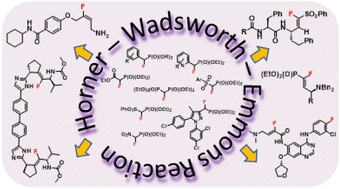Horner–Wadsworth–Emmons reaction as an excellent tool in the synthesis of fluoro-containing biologically important compounds
Abstract
Selective introduction of a double bond motif into a multifunctional organic compound is always a big challenge. The Horner–Wadsworth–Emmons reaction is one of the most reliable, simple, and stereoselective olefination methods, widely used in organic chemistry. To the best of our knowledge, no review article on the application of HWE reaction in the synthesis of fluoroorganic compounds with direct biological interest has been published in recent years. The importance of the HWE reaction should be emphasised due to its simplicity and stereoselectivity. Under mild conditions and in one step, valuable compounds can be obtained. The HWE reaction is primarily a great tool in the synthesis of fluoroolefins that are, among others, peptide bond mimetics. Therefore, it can serve as an indispensable approach to access peptide bioisosteres and, consequently, analogues of numerous enzyme inhibitors. The protocol may be utilized to obtain florinated vinylphosphonate, vinylsulfone or sulfonate derivatives, which exhibit biological activity. In this review article, we would like to summarize the HWE reaction output of the last 12 years (since 2010).



 Please wait while we load your content...
Please wait while we load your content...